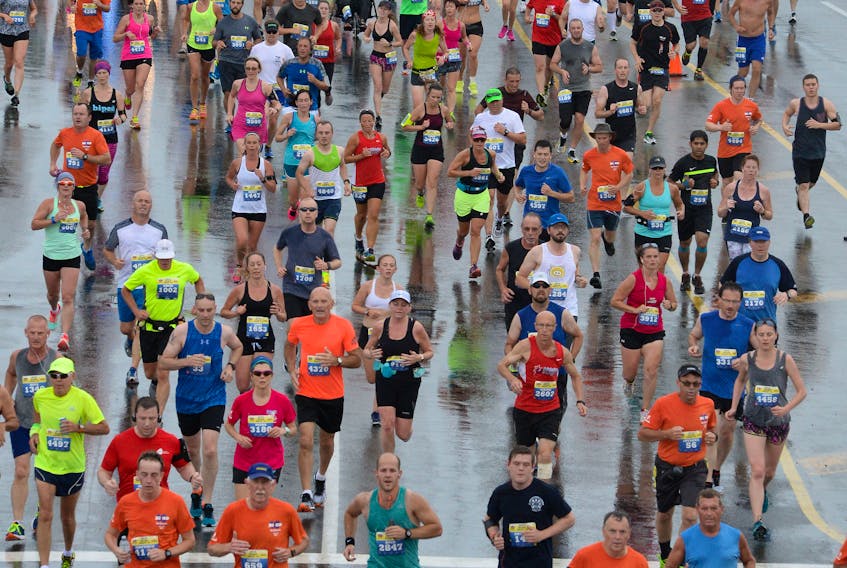Jason White
Special to The Telegram
I hope everyone had a great winter. If you are reading this article, I hope it means that you are thinking about participating in the 92nd edition of the Tely 10 on July 28.
Well, let me tell you that you should absolutely go for it! I have done many races (15 Tely 10s), and nothing feels quite like this event. The support you get from the local crowds is amazing as you run through the Town of Paradise, the City of Mount Pearl finishing at the beautiful Bannerman Park in the heart of St. John’s. I hope this program gives you the confidence to get to the start line feeling strong and finishing with a smile.
I have been in the health and fitness industry for nearly 20 years. Through that period of time, one thing has remained constant: getting yourself checked. I recommend you consult your physician before taking on this program. Many people have no idea what is going on with their body until they take on an exercise program. So for your own piece of mind, and that of your families, just make sure everything is working the way it should.
The basics of the program are simple. We start light, build intensity and duration of the runs over the course of 12 weeks.
In the past I have advocated a walk/run style for the first few weeks. For this year, I have dropped it from the programming and only having the walk/run segments on the long runs. If you are new to the concept, it simply means walk for a certain amount of time, usually one minute, then run for a certain amount of time anywhere from five to 20 minutes.
I only have this training protocol put in for the long runs on the weekends where you might feel like you want or need a little break. Now, if you feel like you need to take walk breaks during the sessions throughout the week, by all means do so.
I have Maximum Heart Rate (Max HR) percentages listed for the runs. If you are running with a Heart Rate monitor, it will show you if you are running within the appropriate zone. By using this method, it gives you the feedback you need to know you are not going out too hard for what should be an easy run.
The formula to calculate your heart rate zones is Max HR = 220-(Age). If we were to calculate this for a 30-year-old runner, it would be: 220- (30) = 190 beats per minute (bpm).
Multiply that by the percentage to get your upper and lower limits.
To continue with the 30-year-old runner, 190 x (0.65) = 123 beats per minute (bpm) is where your heart rate should be at 65 per cent of your Maximum Heart Rate. Some of the modern GPS watches or other fitness trackers will calculate your zones based on your profile you enter.
If you don’t run with a any kind of fitness tracker, use the talk test. If you can talk to your run partner very easily, you are most likely running at the 65-70 per cent Max HR range. If you are struggling to get the words out, you are in the higher 80-85 per cent range and may need to adjust your pace.
Cross Training is a great way to work on fitness without running. It's a great time to get on a bike, rowing machine or go for a swim to get the much needed cardio but without the demands of running.
I have 60 minutes of cross training listed over the course of the program. This can also include any resistance training that you would like to do as well. Just give yourself the time to enjoy other activities over the summer.
If you want to get stronger as a runner, one of the easiest ways to do it is hill training. There are hills on the Tely course. Sure within the first mile you are climbing, and of course the infamous Mile 7 hill, so get those hills into the program. These sessions aren’t glamorous, but they are effective.
Find a hill that is manageable to run up at a good pace. The idea is for it not to be too steep like Signal Hill. If you are a numbers person, an incline of 10-12 per cent is perfect. Start at the bottom and increase your pace to faster than normal running pace, about 85 per cent of Max HR. Focus in your form and maintaining the pace. When you reached the two-minute interval, jog back to the bottom.
ake sure to jog to the bottom, working on the downhill running is just as important as the uphill. As you run downhill, your muscles are decelerating your weight against gravity and the decline, keeping you in control. So stay focused during the downhill portion.
Once this section is complete, we move into interval training. So you will be running short segments at a faster pace than you would normally run, or that you will be doing for the Tely 10. I want you to do these workouts at 10K race pace, or what you feel like a 10K race pace would be, somewhere around 75-80 per cent of your MaxHR.
We get uncomfortable during training so the race is comfortable. The intervals should be run at an even pace. You don’t want to run the first one really fast and the last one significantly slower. Even pacing is key, a skill that you will develop once you get use to them.
There are lots of places to do these sessions. Just find yourself and flat safe place to run that is generally free of traffic. It doesn’t have to be a measured off route, as the first few sessions are timed based. Later in the program, there are interval sessions that are distance based. So you might want to mark of an area if you’re not running with a GPS watch.
Towards the end of the program, you will be doing a tempo run. Basically a tempo run is a workout that you run for a specific distance or time based on the event you are training for. These sessions help you settle into the pace you wish to run, giving you the extra boost of confidence that your training has been going well.
For these workouts, aim for a heart rate of 75-80 per cent of MaxHR. These sessions can also be a dress rehearsal for what you plan on racing in. So test what socks or sneakers you plan on wearing during training so you have no surprises come race day.
On workout days, you work hard. So on the easy days, you run easy. I can’t stress that enough! On these days, just get out for an easy paced run. You are still building fitness, but more importantly you are recovering from the previous session. So just relax, run on the trails, run with a friend and talk.
The final week is Taper Week. We slowly drop your training volume leading up to the event. This helps you store energy while not taking a complete break. You need to keep moving to help you be sharp on Tely 10 Sunday.
A few things to mention. For the past few race seasons, we have been strongly advocating that you not wearing headphones while running. The NLAA and its running club members have come up with a policy for the 2019 season. It is for the safety of you and all the other participants as the Tely 10 route isn’t a closed course. So please adhere to the guidelines.
On race day, if it is warm, I would strongly recommend wearing a running singlet to allow for more ventilation during the run. Always remember to hydrate, and smile when you cross the finish line as you want to look happy when you finally get to Bannerman Park.
Well, there it is, another year in the books. I enjoy doing this each year. I love helping people accomplish their goals. This is a great event run each and every year right here in Newfoundland. I hope the summer of training is kind to you. Get out on the trails, join a run group, get neighbours or co-workers onboard with you and register! You will get a lift each and every mile from those cheering the runners on all the way to the finish line. Don’t forget to smile when you round the corner and hit the final stretch on Bannerman Road. You just never know who is watching and who you may inspire to do it next year.
Jason White is a St. John’s-based personal trainer.
Maximum Heart Rate (Max HR) = 220 – (Age): This formula is used to help determine your effort level based on how fast your heart is beating. Example: 30 year old runner: 220 – (30) = 190. Therefore, 190 x (0.65) = 123 beats per minute (bpm) is where your heart rate should be.
Cross Training: Other cardio activities that will use other muscles that will help to prevent injuries during training. Examples are swimming laps, going for a bike ride or weight training.
Rest Days: These days play an important role in your training program. They are designed to give your body a break from training and allow you to remain healthy, prevent injuries, achieve physiological gains and help you concentrate on your overall goal.
Hilly Repeats: These days are designed to help build your running strength in your legs. Pick a hill that isn’t too steep. Increase pace up the hill (MAX HR of 80-85% on hills). After you have completed the hill, jog to the bottom at a steady pace (65-75% of Max HR) and repeat.
Hill Workouts: These days are designed to help build your running strength in your legs. The Hill shouldn’t too steep. But steep enough to be a challenge when you increase your pace. (MAX HR of 75-85% on hills). After you have completed the hill, jog back down to bottom at a steady pace (65-75% of Max HR). Repeat for a number of repetitions suggested.
Speed Work: These workouts are key to improving your running. Each workout will increase your ability to run at an increased pace for longer. (MAX HR of 80-85%)
Easy Runs: Doesn’t require a lot of effort to maintain the pace. Conversation with a running partner is easily maintained.
Tempo Run: This run is done at or very close to your goal race pace. (MAX HR of 75-80%)
Tapering: This week you don’t want to do anything out of the ordinary. You have worked hard over the last 11 weeks. So rest up your legs but keep them fresh for race day. You have worked hard over the last 11 weeks.









